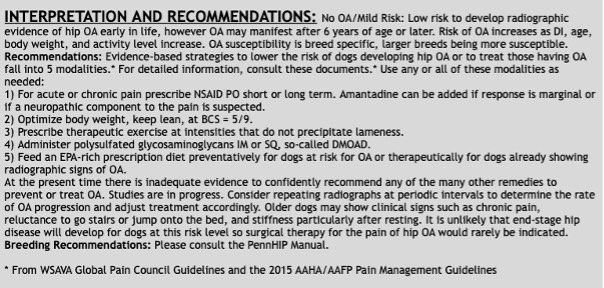Hip & Elbow Scoring
PennHIP
PennHIP is a radiographic method for evaluating the hip joints to screen for Canine Hip Dysplasia, the most common orthopaedic problem seen in dogs. This method of screening is the most accurate in identifying dogs that are susceptible to hip dysplasia and can be performed as early as 16 weeks of age. The PennHIP screening includes three radiographs in order to evaluate both arthritis and laxity.
The three radiograph views include:
- Distraction View (using a PennHip distraction device)
- Compression View
- Hip Extended View
A report is generated following specialised evaluation and comprises of the following key parts:
Distraction Index (DI)
The Distraction Index (DI) is the measurement of passive joint laxity. To arrive at this measurement, the patient is heavily sedated or anesthetized and the hip joints are radiographed in maximum compression and in maximum distraction. The measurement is the inherent distance the femoral head can be displaced from the hip socket which is expressed as a number between 0 and 1.0.
A DI near 0 indicates little joint laxity, meaning very tight hips, and a DI closer to 1.0 indicates a high degree of laxity, meaning very loose hips. A dog with tighter hips is less likely to develop hip dysplasia than a dog with looser hips.
What does the DI Score mean?
| DI Score | DI Score Indication | Comments |
| < 0.3 | no risk of hip dysplasia or arthritis | Breeding is recommended. It is unlikely for a dog not considered for breeding to ever have hip problems or require management, with the exemption of injury or accidents. |
| 0.3 – 0.7 | mild to moderate risk of hip dysplasia | Any dog with any risk should be carefully considered for breeding. Dogs with a score of > 0.3 are at risk of arthritis. It is strongly recommended to discuss preventative management with a veterinarian. Dogs under the age of 20 weeks are great candidates for Juvenile Pubic Symphysiodesis, a surgical procedure to prevent the progression of hip dysplasia in young dogs. |
| > 0.7 | arthritis is inevitable | It is difficult to predict the clinical consequence for the individual dog. It is strongly recommended to discuss preventative management for the individual patient with a veterinarian. |
Osteoarthritis Assessment
The osteoarthritis assessment will describe the presence or absence of osteoarthritis. If arthritis is detected, this confirms the presence of hip dysplasia.

Information for Breeders
Information collected in the PennHIP international database permits informed selection of breeding stock based on the hop tightness, relative to other members of the same canine breed. This information can be used to minimise the incidence and severity of Canine Hip Dysplasia in future generations by applying selection pressure towards tighter hips.
PennHIP has the highest heritability value which means PennHIP is the best and most accurate test available for preventing hip dysplasia in genetic lines.
Any dog with any risk should be carefully considered for breeding. Dogs with a score of > 0.3 are at risk of arthritis.

Australian National Kennel Council (ANKC) Scoring System
Hip Scoring
Hip scoring is open to dogs that are at least 12 months of age. Hip scoring evaluates the dog using a single radiographic view of the pelvis extended. The radiologist uses a variety of criteria when evaluating a hip score, with scores between 0-6 allocated for each hip joint, except the caudal acetabular edge which is scored out of 5. The right and left scores are added together to give a total score out of 10. The higher the score, the higher the indication of hip dysplasia and/or arthritis.
It’s recommended that dogs are only bred with a score lower than the ‘breed average’. This can be found on the ANKC Register.
Elbow Scoring
Elbow dysplasia is the most common cause of lameness on a front leg in young dogs, especially of the larger breeds. Dysplasia refers to abnormal development, in this case of the elbow joint. Elbow dysplasia is a condition involving multiple development abnormalities of the elbow joint. These aetiologies may occur singularly or in combination and include:
- Fragmented Coronoid Process
- Osteochondritis
- Ununited Anconeal Process
The radiologist performs an extreme flexed mediolateral view of the elbow that is used to diagnose degenerative changes.
Explanation of Elbow Grades
The only grades involved with elbow scoring are for abnormal elbows with evident radiographic changes associate with secondary joint disease. There are no grades for a normal elbow radiographically. The degree of elbow dysplasia present is indicated by a scale of 0 to 3 (the lower the better, the higher the more severe).
| Elbow Grade | Elbow Grade Indication |
| Grade I Elbow Dysplasia | Presence of osteophytes < 2mm high. Minimal bone change along the anconeal process of the ulna. |
| Grade II Elbow Dysplasia | Presence of osteophytes of 2-5mm high. Additional bone proliferation along anconeal process and subchondral bone changes. |
| Grade III Elbow Dysplasia | Presence of osteophytes of > 5mm high. Well-developed degenerative joint disease with bone proliferation along anconeal process being greater than 5mm. |
Information For Breeders
It is strongly recommended that any dog with a score of 1-3 (in one or both elbows) are not bred.
Booking Procedure
PennHIP and ANKC Scoring (Hip and Elbow) are available at our clinic. In order to produce diagnostic quality radiographs, heavy sedation is required and therefore your dog will need to be fasted from the night prior to their booking. Your dog will be admitted as a patient and stay with us over the day. To book a scoring appointment or for any questions regarding scoring, please give our friendly team a call on 07 4987 6800.



